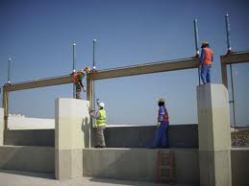The Heavy duty Titeseal Copolymer Sluice Gate is a non-metallic, corrosion resistant sluice gate that provides the engineer with a superior alternative to other plastic gates and competes well with stainless steel and cast iron gates. It is designed to handle high head applications of 25 feet or more in seating and unseating service. The guide includes a top closure bar that allows the gate to seal around all four sides. This gate is also often used for open channel weir applications. This gate is like the Wedging Titeseal gate, a high performance, low leakage slide gate.
The gates are individually fabricated and can be designed to cover most opening. Sizing can range from about one foot square to over ten feet in width and height.
Copolymer gates can range in thickness from 2-l/2 inches to over 12 inches depending on the head and deflection requirement.
The gate is fabricated using a reinforced copolymer composite material (FRP), which totally encapsulates an internal structural steel matrix, and has no seams, joints or cut edges. The core of the gate is completely sealed against any corrosive attack by water or chemicals that might be present in the stream.
Heavy Duty Titeseal sluice gates do not use wall thimbles. Instead, the guide is anchored to a flat surface and approximately one inch of grout is used to permanently seal between the guide and the wall. The guide is normally fabricated using T-304 or T-316 stainless steel, but FRP guides and other more exotic metals are available. Plasti-Fab has fabrication experience with Monel, Hasalloy and Aquamet to name a few.
GuidesThe gates require specially formed guides, but these will still be classified as embedded, surface mounted, or in-channel according to how they are mounted. Surface mounted guides bolt to the face of the wall around an opening using special slotted clips that slide onto the anchor bolts. In-channel guides bolt to the inside face of an existing channel.
SEALS Heavy Duty Titeseal Sluice Gates have a virgin neoprene J-seal and wedged bottom seal mechanically fastened to the gate. Neoprene forms a true seal that has high resilience and durability, and will not bridge or gap over small debris. It has been used successfully by the U. S. Army Corps of Engineers in hydro-electric dams for the past seventy years as the proven seal of choice. Plasti-Fab will not use sponge rubber, which has low compression set characteristics and low tear strength.
Mounted on the opposite side of the gate is a UHMW low-friction sliding surface which helps to reduce the lifting force required to move the gate. As the gate starts to open, the seal is released from contact with the wedge. This allows the gate to move freely in the guide with lower operating forces. The adjustable wedging bar in the guide allows the gate to be fine-tuned to achieve the lowest possible leakage rates. The end result is leakage rates that are much less than the AWWA standard for sluice gates (AWWA C-501 establishes leakage of no more than 0.1 GPM/foot of wetted perimeter for a seating head, and 0.2 GPM/foot of wetted perimeter for unseating heads of 20 feet or less.)
Example A four-foot by four-foot gate with 20 feet of seating head will require nearly 18,000 pounds of thrust to begin upward movement. (16 ft.2 gate surfaced X 18 ft. Head to the gate center line X 62.4 lbs/ft.3 H2O = 17,971 lbs. breakaway force.)
The entire load plus the weight of the gate and stem must be moved by the stem and lift nut, and supported by the head frame and lift. For periods of up to 20 years (sic). In addition, AWWA C-501 sluice gate standards require that this initial gate movement should take place with no more than 25 to 40 pound pull on the handwheel or crank. All this means that proper sizing of the lift, stem, and other gate components is critical.
All lifts used by Plasti-Fab will have ball bearings, and many will be geared. Geared lifts can also be operated by an electric or gas powered portable operator to reduce cycling time. Plasti-Fab also uses electric, pneumatic, and hydraulic actuators. We have worked with most of the major gate and operator manufacturers in the U. S. for over twenty years.
LOCATION May include any size open channels and any wall opening that will have a seating or un-seating head greater than the opening itself.
WHY BUY PLASTI-FAB?
- The Heavy Duty Titeseal Sluice Gate exceeds any other metallic gates. We can give the owner, engineer, and contractor an alternate to this high-priced proprietary spec., that exceed the functional aspects of the specification in all areas.
- The seals are mounted to the gate which is a unique feature to most other gates on the market today. This allows the adjustment and replacement of the seals without dewatering of the channel.
- Plasti-Fab can fabricate using a large variety of high corrosion performance metals and resins.
- Gate will perform when needed for emergency shut off, spill containment or any other critical shut-off situation.
- Wide range of experience with customer requirements that will help get the job done right the first time.



